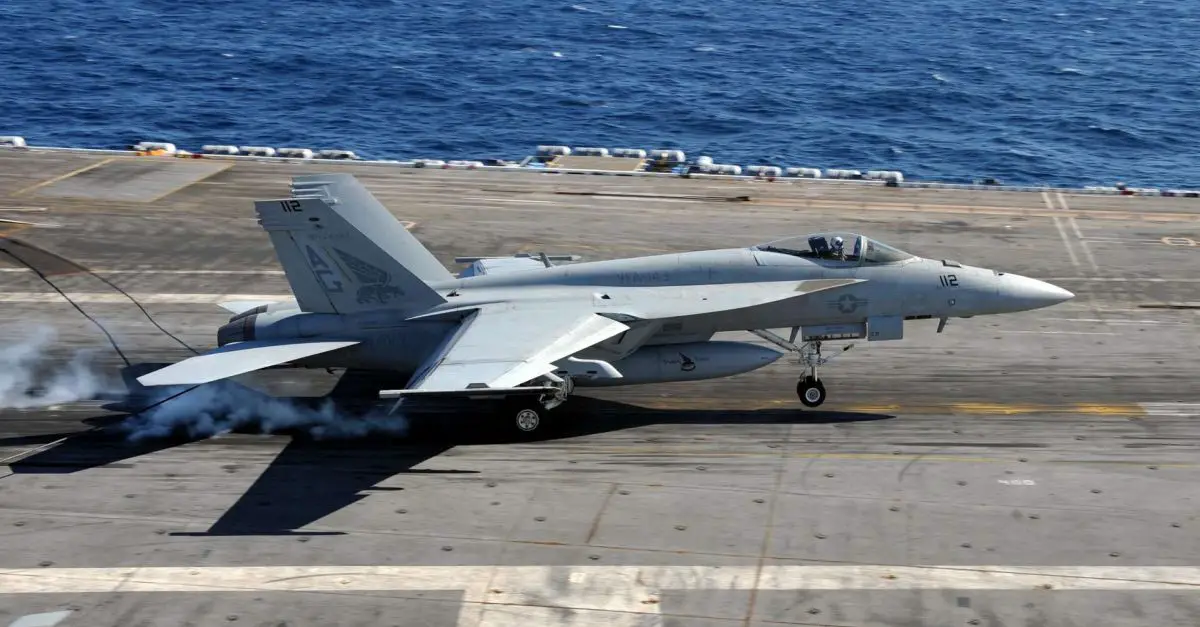Breaking News
Breaking News: US Navy F/A-18 Fighter Jets Deploy AIM-9X and AARGM Missiles in First Combat Against Houthis.
According to information published by the U.S. media outlet 'Navy Times,' U.S. Navy F/A-18 Super Hornet fighter jets embarked aboard the aircraft carrier USS Dwight D. Eisenhower have used AIM-9X short-range air-to-air missiles and Advanced Anti-Radiation Guided Missiles (AARGMs) for the first time in combat operations against the Houthis, an Iranian-backed group in Yemen.
Follow Army Recognition on Google News at this link

A U.S. Navy F/A-18E Super Hornet assigned to the Pukin Dogs of Strike Fighter Squadron (VFA) 143 catches an arresting wire aboard the aircraft carrier USS Dwight D. Eisenhower. (Picture source: U.S. DoD)
Latest combat operations of the U.S. Navy, have recently involved the USS Dwight D. Eisenhower and Houthi rebels in Yemen. The U.S. and U.K. have carried out several airstrikes against Houthi targets in Yemen. These strikes were conducted by F/A-18 Super Hornet fighter jets from the USS Dwight D. Eisenhower, as well as other U.S. and allied military assets. The targets included munitions depots, missile launch systems, production facilities, and air defense radar systems used by the Houthis.
In retaliation, the Houthis claimed to have launched missile and drone attacks against the USS Dwight D. Eisenhower, although U.S. defense officials have denied that the carrier was hit or damaged. The Houthis have been increasing their attacks on shipping in the Red Sea, linking their actions to the conflict in Gaza and expressing solidarity with Hamas.
The F/A-18 Super Hornet is a twin-engine, carrier-capable multirole fighter aircraft developed by Boeing for the United States Navy. It is an evolution of the original F/A-18 Hornet, with a larger airframe, greater fuel capacity, more powerful engines, and advanced avionics. The Super Hornet comes in two variants: the single-seat F/A-18E and the tandem-seat F/A-18F. It is designed to perform a variety of missions, including air superiority, fighter escort, reconnaissance, aerial refueling, close air support, air defense suppression, and day/night precision strikes.
First introduced in the late 1990s, the F/A-18 Super Hornet has become a critical component of the U.S. Navy's air wing. It boasts a top speed of Mach 1.6 and a combat range of over 1,200 nautical miles. The aircraft is equipped with advanced radar, targeting systems, and electronic warfare capabilities, making it a versatile and formidable platform in modern naval warfare. The Super Hornet's flexibility and reliability have ensured its continued service, with ongoing upgrades to maintain its technological edge.
The AIM-9X is the latest variant of the AIM-9 Sidewinder, a highly advanced short-range air-to-air missile developed by Raytheon for the United States and allied nations. This fifth-generation missile features significant improvements over its predecessors, including an advanced infrared homing seeker with a high off-boresight capability, which allows pilots to lock onto and engage targets at wider angles and greater distances. It also includes thrust vectoring control for enhanced maneuverability, enabling it to engage agile and fast-moving enemy aircraft effectively.
The AIM-9X is equipped with a range of sophisticated technologies such as an internal cooling system, a reduced-smoke rocket motor to decrease visual detection, and improved counter-countermeasures to resist jamming. Its versatility extends beyond air-to-air combat; it can also be used for surface attack missions when integrated with various launch platforms. The missile's design supports easy integration with modern fighter aircraft, including the F-22 Raptor, F-35 Lightning II, and F/A-18 Super Hornet, making it a crucial component in maintaining air superiority.
The Advanced Anti-Radiation Guided Missile (AARGM) is an advanced air-to-surface missile designed for the suppression and destruction of enemy air defenses. Developed by Northrop Grumman, it is an upgrade to the older AGM-88 HARM (High-speed Anti-Radiation Missile). The AARGM features enhanced capabilities, including an advanced multi-sensor system with a millimeter-wave radar, GPS/INS guidance, and a digital anti-radiation homing (ARH) receiver. These enhancements allow the AARGM to detect, track, and engage radar-emitting targets with high precision, even if the enemy attempts to shut down their radar systems to avoid detection.
The missile is capable of engaging both stationary and moving targets and can be used in a variety of mission profiles, including destruction of enemy air defenses (DEAD) and suppression of enemy air defenses (SEAD). Its advanced targeting system enables it to provide real-time targeting updates, ensuring greater accuracy and effectiveness. The AARGM is compatible with several aircraft platforms, including the F/A-18 Super Hornet, EA-18G Growler, F-35 Lightning II, and Tornado ECR. This makes it a versatile and valuable asset in modern electronic warfare and air combat operations.
The use of these sophisticated missiles by the U.S. Navy underscores the escalating efforts to neutralize the Houthi threat, particularly their radar and air defense systems, which pose a significant risk to regional security and international shipping lanes. The employment of such advanced weaponry demonstrates the U.S. Navy's commitment to maintaining air superiority and ensuring the safety of its operations in hostile environments. This strategic move not only aims to degrade the operational capabilities of the Houthis but also sends a strong message regarding the U.S. military's readiness to employ advanced technology in defense of its interests and those of its allies in the region.


























